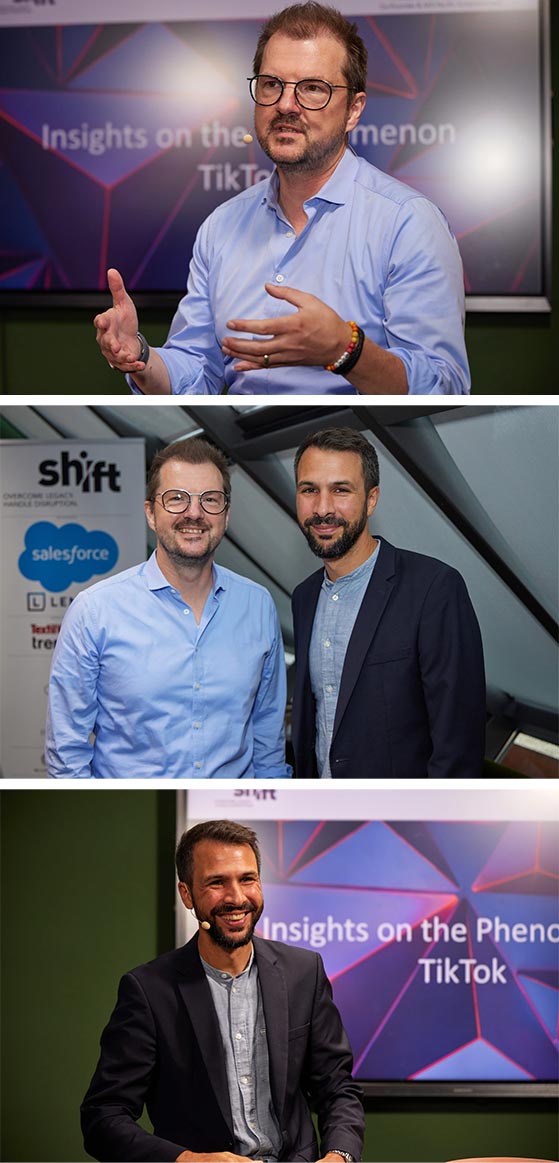TikTok has long since overtaken the mother of all social media platforms in terms of downloads. “We aim to provide a creative home for everyone,” affirmed David Roland, Head of Brand DACH at the high-flying app, as he set out its recipe for success. It’s the algorithm in the background that makes the difference. Rewards are reaped by original content, not necessarily range and reach. And that’s exactly what makes TikTok so interesting for companies, too.

David Roland makes no attempt to sidestep the issue of potential addiction: “It’s like eating chips,” said the creative thinker, who joined TikTok two years ago: you only intended to snack on three or four, but suddenly the pack is empty.Translated into video clips, that means users spend an average of 80 minutes per day on their favorite app. “Longer than Netflix,” triumphed Roland. So that’s a good 300 chips, er, clips, seven days a week. Given this, he was happy to provide tips on how to limit children’s consumption at home.
“We’re pretty proud of what happens on our platform,” said Roland. And the success has outperformed even their wildest dreams. In conversation with Sven Schäferkord from Pacific Entertainment, an agency that brings together creative minds and entrepreneurs, Roland spilled the beans on the figures: 1.2 billion TikTok users per month, 100 million of them in Europe, and operations in a total of 150 countries. No question that this is a global video player. And all that although the European branch was set up during the pandemic, largely in socially distanced Zoom meetings.Incidentally, the company is currently only at “Chapter One of its overall development,” and envisages a plenty of potential for future development.
The times when TikTok was notoriously crammed with dance videos and lip-syncing are long over. The audience age is creeping up as kids introduce their parents to TikTok. The current debate about TikTok reminds Roland––whose part career includes a stint at Google––of the once-heated discussions about YouTube, today a video giant.
TikTok’s great strength is the informality of most videos on the platform. Its users’ collective creativity exudes a casual flair that wins over even business members. On the subject of co-creation, Roland pointed out, “It’s a huge opportunity for companies.” He talked about occasionally hearing a company say, “But we don’t have a platform on TikTok,” “and then we show them what’s happening right there with their brand!” In fact, in a trend that’s rapidly becoming normality on the technology-driven market, a product is often already featured online even before its own manufacturer has officially launched the advertising.
A possible approach to a TikTok collaboration is a strategy chosen by Gucci; the fashion giant uploaded posts about its products to its own channel, even if the message or style of the clips was less than a perfect fit for its marketing strategy. Secondly, the creators of the best clips were featured as models for the next collection. A win-win situation: Gucci invited consumers on board that already had a close relationship with the brand––and usually a huge reach as well. A good example of what many entrepreneurial pioneers have often announced at our SHIFT conferences: relevance with a younger target group is primarily achieved by staying “elastic” and allowing user and creator to play an active participatory role instead of imposing strict top-down specifications. In addition, it’s vital for companies not to take themselves too seriously. According to Roland, the most successful clips on TikTok are far from glossy, perfect commercials; they’re more likely to be the bloopers and outtakes from the video production.
So where is this journey going? Nobody knows, said Roland; it’s traveling far too fast and is far too decentralized.Many waves of hype only catch the eye when companies announce a product is sold out––as happened with a beverage from Volvic. Or, as with David Roland, when his own children tell him about them.
One thing is certain, stated Roland firmly: reaching Generation Z is easier on TikTok than on Facebook, and even than Instagram in some cases. Live events are an area under close observation by the string-pullers in the background. Roland is confident that eCommerce will become a key topic, perhaps even “very fast.” However, he pointed out that the community expects content on the subject of sustainability. The range of development potential is huge. For that reason, too, Roland believes that unlike many of its media competitors, TikTok can exist without classic external advertising.
Roland concluded by addressing a crucial issue, noting the importance of removing the resentment buried in TikTok’s earliest beginnings: the alleged dependence on China, accompanied by the issue of human rights and potential censorship.
“The data are not located in China, but in the USA and in Singapore, and a further data center will open in Ireland next year,” reassured Roland, confirming that the work processes are now separate from China. Although TikTok still has Douyin as its subsidiary, the platform is currently a great example of how a market can achieve strong growth without being beholden to the world’s most populous country.